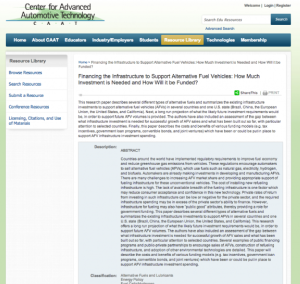Financing the Infrastructure to Support Alternative Fuel Vehicles: How Much Investment is Needed and How Will it be Funded?

Countries around the world have implemented regulatory requirements to improve fuel economy and reduce greenhouse gas emissions from vehicles. These regulations encourage automakers to sell alternative fuel vehicles (AFVs), which use fuels such as natural gas, electricity, hydrogen, and biofuels. Automakers are already making investments in developing and manufacturing AFVs. There are many challenges to increasing AFV market share and providing appropriate support of fueling infrastructure for these unconventional vehicles. The cost of installing new refueling infrastructure is high. The lack of available breadth of the fueling infrastructure is one factor which may reduce consumer acceptance and confidence in this new technology. Private rates of return from investing in such infrastructure can be low or negative for the private sector, and the required infrastructure spending may be in excess of the private sector’s ability to finance. However, infrastructure for fueling may also have “public good” attributes, thereby providing a role for government funding. This paper describes several different types of alternative fuels and summarizes the existing infrastructure investments to support AFVs in several countries and one U.S. state (Brazil, China, the European Union, the United States, and California).
This research offers a long run projection of what the likely future investment requirements would be, in order to support future AFV volumes. The authors have also included an assessment of the gap between what infrastructure investment is needed for successful growth of AFV sales and what has been built out so far, with particular attention to selected countries. Several examples of public financing programs and public-private partnerships to encourage sales of AFVs, construction of refueling infrastructure, and adoption of other environmental technologies are detailed. This paper will describe the costs and benefits of various funding models (e.g. tax incentives, government loan programs, convertible bonds, and joint ventures) which have been or could be put in place to support AFV infrastructure investment spending.

Comments